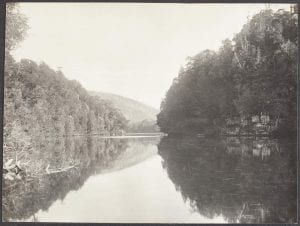Erroneous Ambitions: A geo-temporal analysis of the colonial project
Timothy Williams is enrolled in the Creative Writing PhD program in the School of Culture and Communication at The University of Melbourne. His research is on video games and adaptive storytelling.
Not that the map itself is an explanation, of course: but at least, it offers a model of the narrative universe which rearranges its components in a non-trivial way, and may bring some hidden patterns to the surface. (Moretti 53–54)
My approach to the Commercial Traveller’s Association (CTA) digitised image collection at The University of Melbourne Archives was to search for the narrative of the collection. With inspiration from Franco Moretti I opted not for the instinctual close-reading but for the distant reading and a search for narrative through geography and time.
The CTA collection spans a period of forty-two years (1919-1961), with many photographs intended as tourism brochures for travelling sales-people. I waded into the greyscale depths and selected two years separated by twenty-five years of national progress: 1921 and 1946. A geo-temporal analysis of these two years shows how Australia’s international image underwent a shift from natural majesty towards industrial hub in documenting the nation with pictures.
This link provides access to a custom map I created to document this geo-temporal analysis.

The map depicts 1921 which is the CTA collection’s earliest year with a significant amount of entries (1919 features just one entry) and is therefore an ideal starting point for determining the CTA’s early intentions in representing Australia. A geographical plotting of these 17 entries suggests a preoccupation with Australia’s natural landscape: a) on a waterway or coastal area, and/or b) outside major population centres. The content of rugged landscapes, scenic views and a natural beauty almost untouched by the Anthropocene is elaborated as a mythos of the ‘great land’.[1] Notably, all these images geographically hug Australia’s coastline, a coastline lush with green vegetation and a far cry from the—perhaps significantly less appealing at the time—dry red deserts of Central Australia. This geographical focus on low-population/high-vegetation is suitably in line with the historical context of 1921, in particular the post-WWI Soldier Settlement Scheme and the furthering of Australia’s image as a land ‘ripe’ for expansive settlement.

By way of contrast, 1946’s twenty-five entries plot an alternative horizon, that celebrates Australia’s accomplished, and now modernising, project. The focus is on more on human industry and mastery over the natural landscape. This shift in the immediate context of post-WWII Australia provides an historical lynchpin upon which ideas of victory and the associated ‘booms’ of economy, industry and population play major roles in the Australian image of itself.
The focus noticeably moves inland towards the great farming plains of Central Victoria and The Golden Mile in Kalgoorlie.[2] Monuments to industry such as the Sydney Harbour Bridge, the NSW Railyards and Sydney’s burgeoning skyline are photographed with a careful eye.[3] And even the more isolated cities of Perth and Hobart are shown to be hubs of white settler education and urban civilisation.[4]


Across this twenty-five year gap the CTA is dutifully concerned with telling a very particular story of Australia. The near total absence of cities, of industry and of people in 1921 has been completely turned around by 1946. The documentation and taming of the natural landscape signals the success of the colonial project and the white man’s ability to erect ‘civilisation’ upon a vast unforgiving continent.
One entry from 1921, a photograph at Kurnell, is one I kept returning to in my interrogation of this collection.[5] Its depiction of the Joseph Banks Monument at Botany Bay National Park foretold this colonial obsession with documenting and mastering the Australian landscape, Banks being a naturalist and botanist. Further investigation, however, revealed this photograph was not of the Sir Joseph Banks memorial at Kurnell (which was erected in 1947). Instead, this is a photograph of the Daniel Carl Solander Monument also at Kurnell. How fitting that the metadata of a collection that tells the story of colonial-Australian claims to possession should replace a British born naturalist over a university educated Swedish doctor.

Works Cited
[1] Reference Codes: 1979.0162.03205, 1979.0162.03357, 1979.0162.03378.
[2] Reference Codes: 1979.0162.02547, 1979.0162.02518, 1979.0162.02529.
[3] Reference Codes: 1979.0162.02512, 1979.0162.02493, 1979.0162.02536.
[4] Reference Codes: 1979.0162.02545, 1979.0162.02543.
[5] Reference Code: 1979.0162.02289.
Leave a Reply